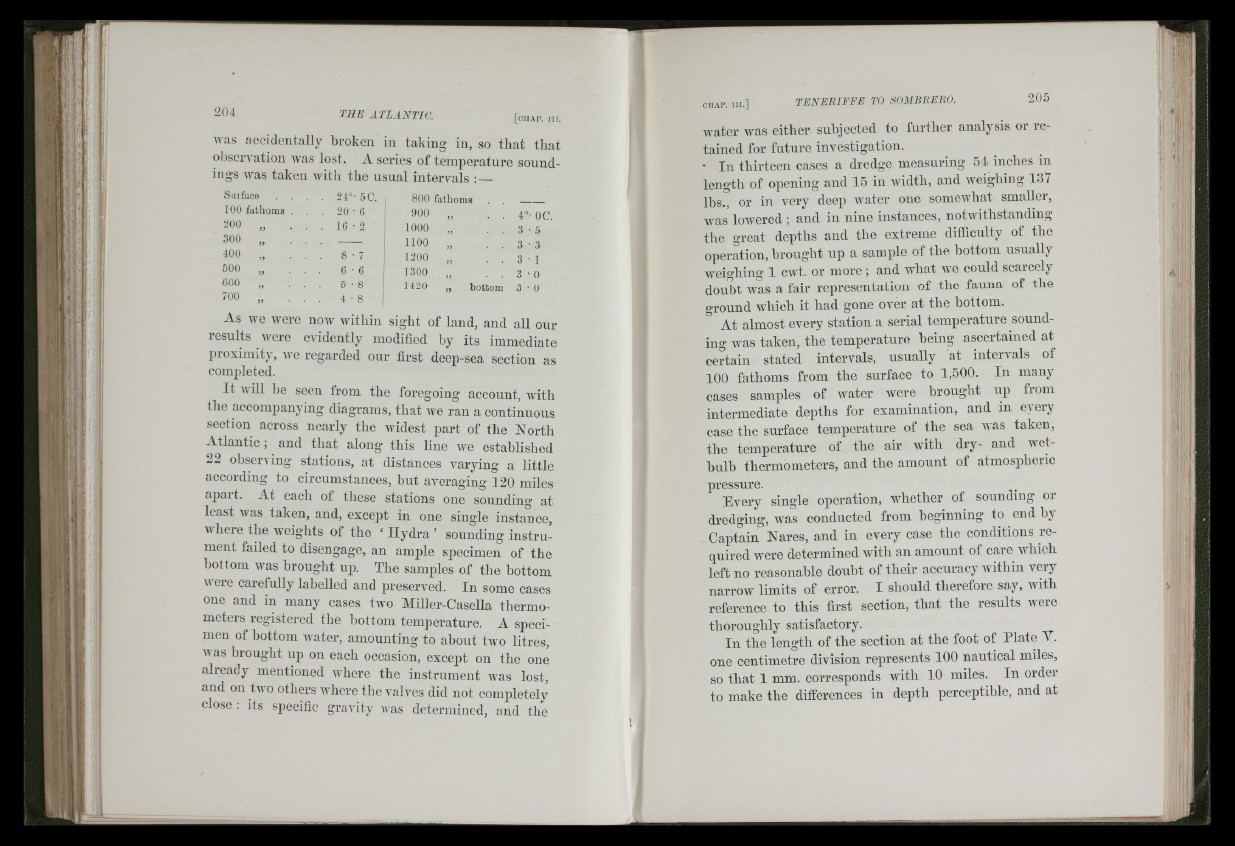
h'ì
i
L-
¡ri
i f i
was accidentally broken in taking in, so tbat that
obsciwation Avas lost. A series of temperature soundings
was taken with the usual intervals :—
Siiiface
100 fatlioms
200 „
300 „
400 „
500 „
GOO „
700 ..
24“- 5C.
20 ■ G
16 • 2
86
5
4
800 fathoms
900 „
1000
1100 „
1200 „
1300 „
1420 bottom
4‘
3
3
3
3
3
• OC.
• 5
■ 3
1
00
As we were now within sight of land, and all our
results were evidently modified by its immediate
proximity, Ave regarded our first deep-sea section as
completed.
It Avill be seen from the foregoing account, with
the accompanying diagrams, that we ran a continuous
section across nearly the Avidest part of the North
Atlantic ; ^ aud that along this line Ave established
22 observing stations, at distances varying a little
according to circumstances, but averaging 120 miles
apart. At each of these stations one sounding at
least was taken, and, except in one single instance,
where the weights of the ‘ Hydra ’ sounding instrument
failed to disengage, an ample specimen of the
hottom was brought up. The samples of the bottom
AA-ere carefully labelled and preserved. In some cases
one aud iu many cases two Miller-Casella thermometers
registered the hottom temperature. A specimen
of bottom Avater, amounting to ahout two litres,
Avas brought up on each occasion, except on the one
already mentioned Avhere the instrument Avas lost,
and on Uvo others where the valves did not completely
close : its specific graAuty was determined, aud the
water Avas either subjected to further analysis or retained
for future investigation.
♦ In thirteen cases a dredge measuring 54 inches in
length of opening and 15 iu Avidth, and AA'eighing 137
lbs., or in very deep Avater one someAvhat smaller,
Avas lowered ; and in nine instances, notwithstanding
the great depths aud the extreme difficulty of the
operation, brought up a sample of the hottom usually
Aveighing 1 cwt. or more; and what Ave could scarcely
doubt Avas a fair representation of the fauna of the
ground whioh it had gone over at the bottom.
At almost every station a serial temperature sounding
A v a s taken, the temperature heing ascertained at
certain stated intervals, usually at intervals of
100 fathoms from the surface to 1,500. In many
cases samples of water were brought up from
intermediate depths for examination, aud iu every
case the surface temperature of the sea Avas taken,
the temperature of the air with dry- and weU
bulb thermometers, aud the amount of atmospheric
pressure.
Every single operation, AA'hetlier of sounding or
dredging, Avas conducted from hegiuuing to end hy
Captain Nares, and iu every case the conditions required
were determined Avith an amount of care Avliich
left no reasonable doubt of their accuracy within very
narrow limits of error. I should therefore say, with
reference to this first section, that the results were
thoroughly satisfactory.
In tiie length of the section at the foot of Plate V.
one centimetre division represents 100 nautical miles,
so that 1 mm. corresponds with 10 miles. In order
to make the differences iu depth perceptible, and at
kfli
I f ,
..“I- ..w
.,1 m.;'
I“M- ■ •